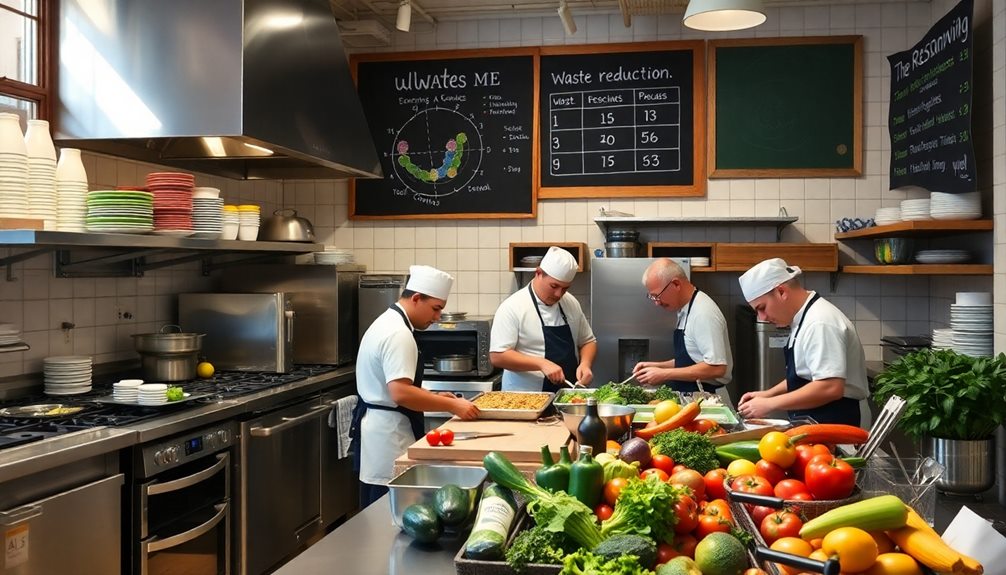Creating a restaurant marketing plan starts with defining your marketing goals and mission statement. Identify your unique selling point to stand out from competitors. Conduct a market analysis to understand local demographics and preferences, and use this insight to shape your target customer strategies. Develop both digital and traditional marketing tactics, like social media and community events, to connect with your audience. Finally, track your success with key performance indicators and be ready to adapt based on results. Keep following for a deeper understanding of each component and how to implement them effectively.
Key Takeaways
- Define specific marketing goals and develop a mission statement that reflects your restaurant's values and purpose.
- Conduct market analysis to identify competitors, local demographics, and trends to inform your strategies.
- Establish a Unique Selling Proposition (USP) that differentiates your restaurant from others in the area.
- Utilize a mix of digital and traditional marketing tactics, including social media, email marketing, and SEO optimization.
- Regularly track key performance indicators (KPIs) to measure success and adapt marketing strategies accordingly.
Importance of a Marketing Plan

A solid marketing plan is indispensable for any restaurant aiming to thrive in today's competitive landscape. With the food service sector expanding rapidly, you need effective restaurant marketing strategies to stand out. Your marketing plan acts as a roadmap to achieving your marketing goals, especially when customer acquisition methods are essential for success.
In a competitive market where new restaurants pop up weekly, driving repeat business and fostering customer loyalty become significant. A documented marketing plan not only enhances accountability within your team but also aligns everyone with your marketing vision and objectives. This alignment guarantees that every effort you make is cohesive and targeted toward engaging your desired audience.
Moreover, performance tracking allows you to adapt your marketing strategies based on real-time data and market trends. By continuously evaluating what resonates with your target customers, you can refine your approach and maintain relevance.
In this ever-evolving industry, a well-crafted marketing plan isn't just a luxury; it's a necessity for staying ahead of the competition and securing long-term success.
Key Components to Include
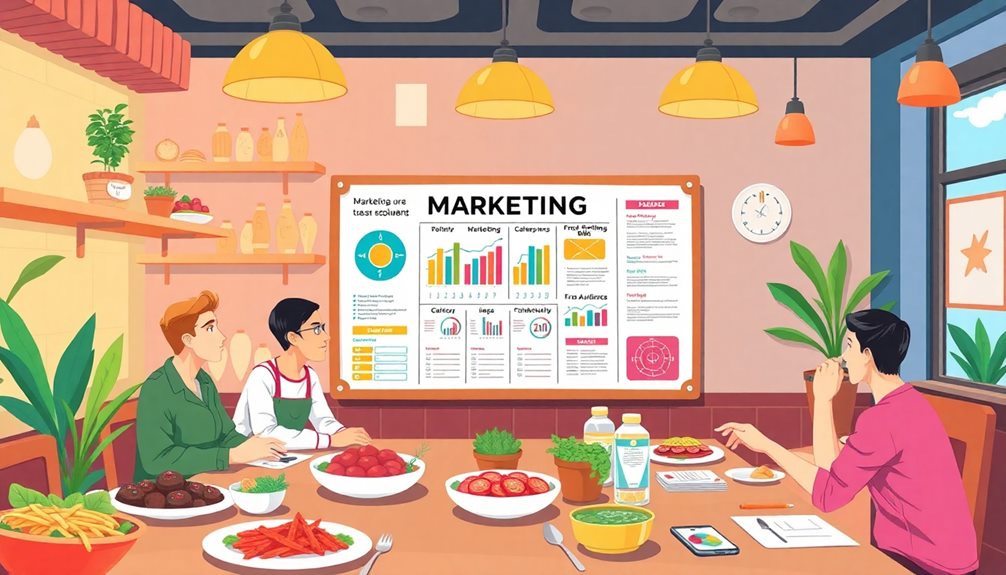
When crafting your restaurant marketing plan, start with an overview that clearly outlines your restaurant's name, location, and concept. This foundational information establishes your brand identity and sets the tone for your marketing strategies.
Here are four key components to include:
- Marketing Goals: Define specific, measurable goals that align with your overall business objectives. This guarantees your efforts yield tangible results.
- Mission Statement: Articulate your restaurant's purpose and values, helping to communicate your unique brand identity. This resonates with both customers and stakeholders.
- Unique Selling Point (USP): Identify what sets your restaurant apart from competitors. Whether it's specialty dishes or outstanding service, your USP is essential for attracting and retaining customers.
- Target Customers: Use demographic and psychographic analysis to understand who your ideal audience is. Tailor your marketing strategies—like social media marketing and digital marketing—to effectively engage them.
Conducting Market Analysis

Understanding your market is vital for developing a successful restaurant marketing plan. Start by conducting a market analysis to identify and research your competitors within a 5-mile radius. This will help you understand their strengths, weaknesses, and market positioning.
A SWOT analysis (Strengths, Weaknesses, Opportunities, Threats) is essential for evaluating your restaurant's current standing and pinpointing areas for growth. Additionally, consider how local wellness trends, such as the rise of natural remedies like essential oils for toothache relief, may influence customer preferences.
Next, explore local demographics, such as age, income level, and dining preferences. This information allows you to tailor your menu and marketing strategies to better meet the needs of your target audience.
Keep a close eye on market trends, including rising food preferences or dietary restrictions, so you can adapt your offerings and marketing messages accordingly.
Don't underestimate the power of customer feedback. Gathering insights through surveys and reviews will give you valuable information about consumer preferences and experiences, which can inform your future marketing and operational strategies.
Competitive Positioning Strategies
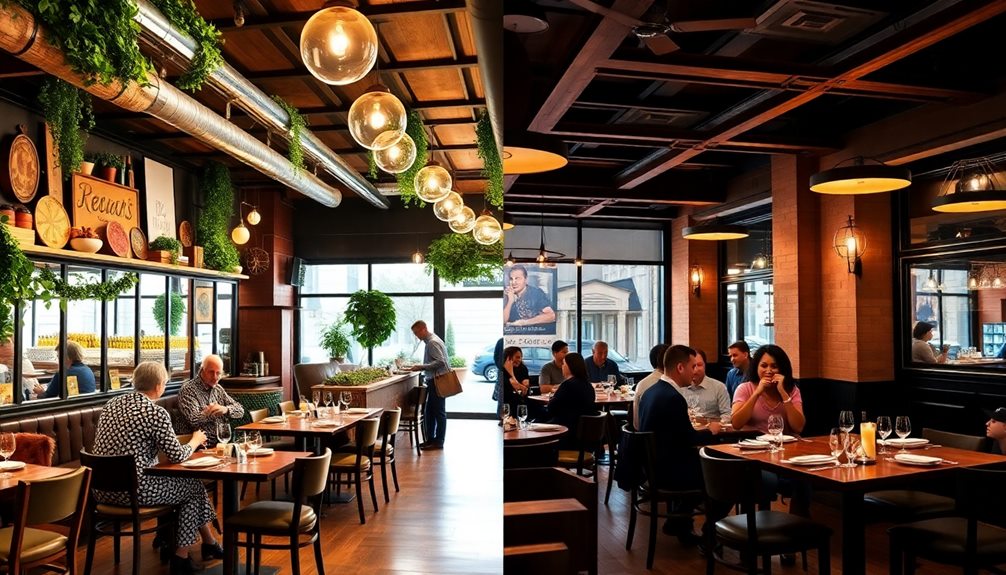
Competitive positioning strategies are essential for your restaurant's success in a crowded market. To effectively carve out your niche, consider the following steps:
- Conduct a SWOT Analysis: Identify your strengths, weaknesses, opportunities, and threats. This insight helps you understand where you stand in relation to competitors and local market trends.
- Research Competitors: Analyze their menu offerings, pricing strategies, and customer engagement. Look for gaps in their approach where your restaurant can stand out.
- Establish Your USP: Your unique selling proposition should clearly articulate what makes your restaurant different. Whether it's specialty dishes, a unique dining experience, or exceptional customer service, make it resonate with your target audience.
- Leverage Local Market Trends: Tailor your marketing messages to reflect consumer preferences in your area. This guarantees your offerings align with what potential customers are seeking.
Developing Marketing Strategies

Creating effective marketing strategies is essential for attracting and retaining customers in the competitive restaurant landscape. Start by establishing a clear Unique Selling Proposition (USP) that sets your restaurant apart. Highlight unique menu items or exceptional service to appeal directly to your target audience.
Additionally, consider incorporating online reputation management techniques to boost customer trust and loyalty through positive online presence and reviews.
Next, leverage digital marketing strategies like social media platforms, email marketing, and optimizing your Google My Business listing. These tools can greatly increase your online visibility and engage potential customers.
Implement a structured marketing calendar to plan promotional activities around seasonal events and holidays. This guarantees your marketing efforts remain timely and relevant.
Conduct a thorough competitive analysis, including a SWOT analysis, to identify market gaps and opportunities. Understanding your competitors allows you to refine your marketing strategies effectively.
Lastly, invest in customer feedback mechanisms, such as surveys and review monitoring. Gathering insights from your diners not only informs adjustments to your marketing strategies but also enhances overall customer satisfaction.
Budgeting for Marketing Efforts

When you're budgeting for marketing efforts, it's vital to establish a clear percentage of your revenue to allocate. For new restaurants, setting aside 25-35% can lay a strong foundation, while established ones might find 12-18% sufficient for ongoing initiatives.
Additionally, just as in handling Louisiana Alimony Laws, it's important to reflect on the financial landscape of your business to guarantee your marketing budget aligns with your overall operational needs.
Regularly reviewing this budget guarantees you're making the most of your resources and adapting to market shifts.
Establishing Marketing Budget
Establishing a marketing budget is essential for the success of your restaurant, especially in the early stages. For new restaurants, allocating 25-35% of your revenue for initial marketing efforts can greatly boost visibility and engagement.
Established restaurants can reduce this to 12-18%, focusing on maintaining a steady presence in the market.
To maximize your marketing spending and ROI, consider these four key strategies:
- Identify Key Channels: Allocate funds to the most profitable marketing channels that resonate with your target audience.
- Adjust During Downturns: If your restaurant faces challenges, consider increasing your marketing budget by 3-10% to attract new clientele.
- Leverage Free Platforms: Utilize free social media and community engagement strategies to enhance your marketing efforts without breaking the bank.
- Regular Reviews: Conduct regular budget reviews to adapt to changing marketing needs and guarantee your strategy remains effective.
Allocating Marketing Resources
Allocating your restaurant's marketing resources effectively is vital for maximizing outreach and engagement. For new restaurants, aim to set aside 25-35% of your revenue for initial marketing efforts. Established restaurants can typically reduce this to 12-18% for ongoing promotions.
Make certain to establish a marketing budget on a monthly or quarterly basis; this guarantees consistency and allows for better resource allocation across various channels.
When allocating funds, consider both digital marketing and traditional methods, like social media ads and printed flyers. This mixed approach maximizes your reach and engages a diverse customer base.
If you encounter downturns, increasing your marketing budget by 3-10% can help attract new clientele and mitigate revenue declines.
Regularly review your budget to adapt to changing marketing needs and confirm you're directing funds toward the most profitable marketing strategies.
Measuring Success and Adaptation

To measure your restaurant's marketing success, you should regularly track key performance indicators like customer acquisition cost and repeat customer rate.
Adjust your strategies based on these results to guarantee you're meeting your goals and maximizing revenue.
Tracking Key Performance Indicators
Tracking Key Performance Indicators (KPIs) is essential for understanding how well your restaurant's marketing strategies are performing. By monitoring KPIs, you can gain valuable insights into customer behavior and the effectiveness of your marketing initiatives.
Here are four key KPIs to focus on:
- Customer Acquisition Cost: Measure how much you're spending to attract new customers, allowing you to assess the efficiency of your marketing strategies.
- Customer Retention Rate: Track the percentage of repeat customers to evaluate the success of your loyalty programs and retention efforts.
- Online Engagement Metrics: Utilize tools like Google Analytics to analyze website traffic, social media shares, and email open rates, providing a clearer picture of customer interaction.
- Average Transaction Value: Monitor the average amount spent per visit to identify trends and optimize your menu or promotions.
Setting measurable goals, like increasing repeat customer visits by 20% within six months, guarantees that you stay focused.
Regular performance reviews of your marketing initiatives allow you to adapt based on the results, keeping your strategies dynamic and responsive to your customers' needs.
Adjusting Strategies Based on Results
Adjusting your marketing strategies based on results is essential for staying relevant and effective in the competitive restaurant industry. To gauge the success of your efforts, regularly track key performance indicators (KPIs) like customer acquisition rates and social media engagement metrics. This data helps you assess which marketing strategies are working and which need tweaking.
Utilize customer feedback tools, such as surveys and review platforms, to gain insights that can inform adjustments to your menu offerings and promotional tactics. Staying updated on market trends and competitor actions also allows you to make proactive changes that maintain your competitive edge.
Conduct periodic performance reviews, ideally quarterly, to evaluate your marketing initiatives. This process helps identify areas for improvement or reallocation of resources to more effective strategies.
Implementing marketing automation tools can streamline data collection and analysis, enabling you to adapt your marketing strategies based on real-time results quickly.
Digital Marketing Tactics
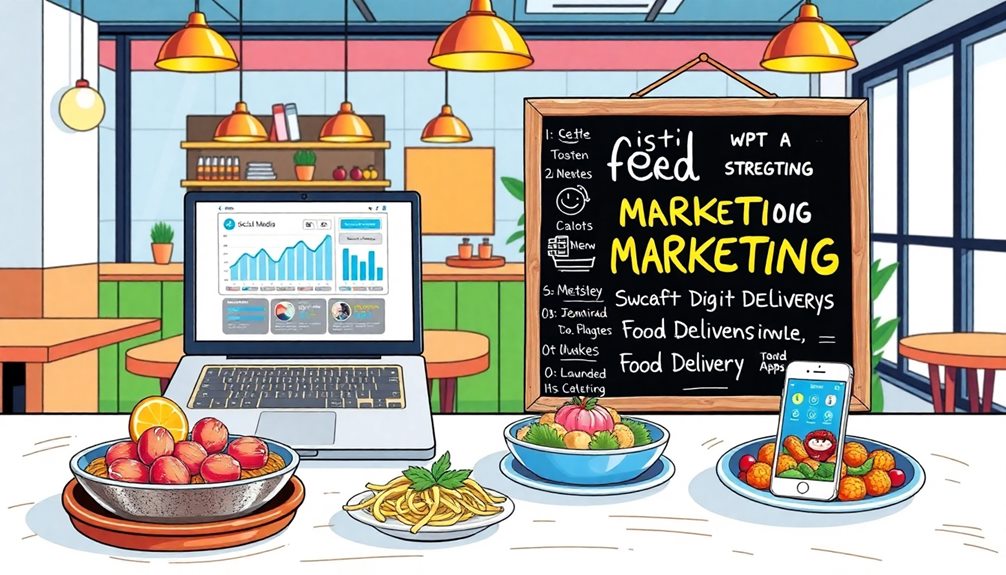
How can your restaurant stand out in today's digital landscape? Implementing effective digital marketing tactics is key to capturing your target market. By utilizing these strategies, you can engage your audience and enhance brand awareness:
- Social Media Marketing: With 48% of Americans using social media to decide where to dine, consistently posting engaging content is essential. Focus on platforms where your target audience hangs out.
- Email Marketing: An impressive 87% of guests prefer receiving emails about specials. Craft a well-planned email strategy to keep interested diners informed and excited about your offerings.
- SEO Optimization: Confirm your website is optimized with relevant keywords and a user-friendly design. This boosts your search engine visibility, attracting more visitors to your restaurant.
- Video Content: Use platforms like TikTok to create authentic, relatable short-form videos. This tactic appeals to broader audiences, including Gen Z and millennials, enhancing your discoverability.
Incorporating these tactics into your Restaurant Marketing Plan won't only keep your audience engaged but also drive foot traffic and increase sales.
Don't underestimate the power of digital marketing!
Traditional Marketing Approaches
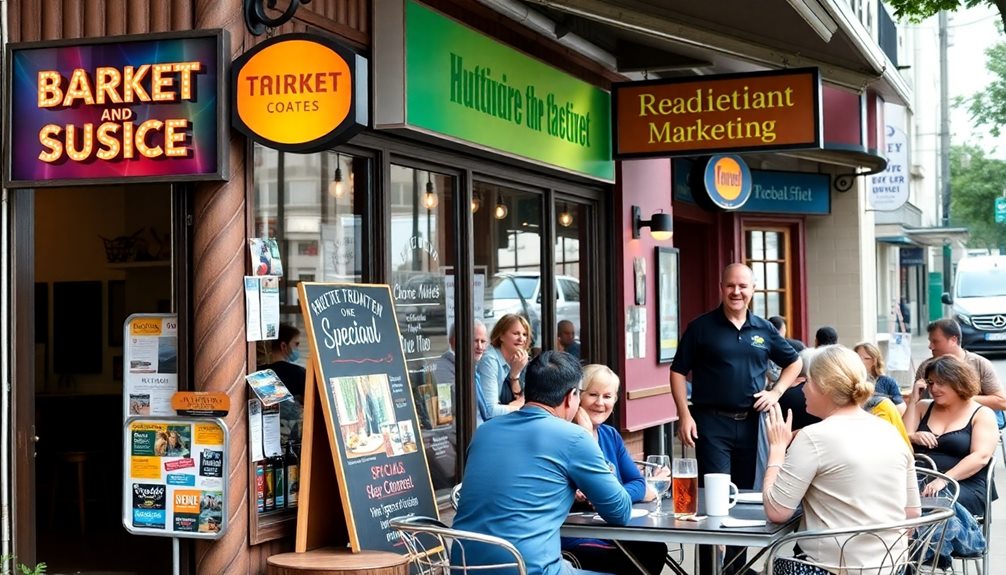
In the bustling world of dining, traditional marketing approaches can still make a significant impact on your restaurant's success. Utilizing traditional marketing methods like printed flyers and posters can effectively capture local attention and drive foot traffic, especially in targeted neighborhoods with high customer density.
Networking with local businesses to collaborate on promotions or host events together enhances your visibility and fosters a sense of community, which can attract new customers. Sponsoring community events, such as local fairs or sports teams, not only boosts brand recognition but also positions you as a supportive member of the area, creating goodwill among potential patrons.
Implementing loyalty programs, whether through traditional punch cards or modern digital systems, can greatly improve customer retention rates by rewarding repeat visits with discounts or free items.
Don't overlook direct mail marketing, either. Sending flyers or menus to targeted neighborhoods remains effective, as 56% of consumers find print marketing to be the most trustworthy form of advertising—especially when you include enticing offers.
Tips for Implementation

Implementing effective marketing strategies requires a clear plan and a commitment to your budget. Start by establishing a marketing budget that allocates 12-18% of revenue for established restaurants and 25-35% for new ones. This guarantees consistency in your promotional efforts while maximizing your returns.
Here are some tips for implementation:
- Adopt an Omnichannel Marketing Approach: Integrate social media, email marketing, and local promotions to effectively reach your diverse target audiences.
- Create a Marketing Calendar: Plan your seasonal events and campaigns in advance. This allows you to execute timely promotions that align with consumer behavior, boosting engagement and sales.
- Track Key Performance Indicators: Regularly evaluate metrics like customer acquisition costs and return on investment (ROI) to assess the effectiveness of your restaurant marketing plan. Making data-driven adjustments can enhance your strategy.
- Utilize Customer Feedback: Implement feedback mechanisms to refine your marketing efforts continuously. Understanding what resonates with your customers can drive repeat business and improve your overall promotional efforts.
Stay committed to these strategies, and watch your restaurant flourish!
Frequently Asked Questions
How to Develop a Marketing Plan for a Restaurant?
To develop a marketing plan for your restaurant, define your mission and USP, analyze the market, set SMART goals, combine digital and traditional marketing strategies, and regularly review KPIs to adapt and improve.
What Are the 7 Steps of a Marketing Plan?
To create a successful marketing plan, you'll want to conduct market analysis, set SMART goals, define your unique selling proposition, develop targeted strategies, implement tactics, measure performance, and adjust as needed for continuous improvement.
What Are the 4 P's of Local Restaurant Marketing?
Imagine crafting a perfect dish—your restaurant's success hinges on the 4 P's: Product, Price, Place, and Promotion. These elements blend together to create a memorable dining experience that keeps customers coming back for more.
What Are the 4 Steps of Creating a Marketing Plan?
To create a marketing plan, you'll define clear goals, conduct market research, develop effective strategies, and set a budget. Regularly monitor your progress and adjust your approach based on feedback and results.
Conclusion
Crafting a restaurant marketing plan is like cooking a perfect dish; it requires the right ingredients and a dash of creativity. By understanding your market and competitors, you'll serve up strategies that resonate with your audience. Embrace both digital and traditional tactics, and remember to measure your success. As you adapt and refine your approach, you'll transform your restaurant into a culinary hotspot, where every customer feels like a VIP. Now, let the flavors of your vision unfold!



